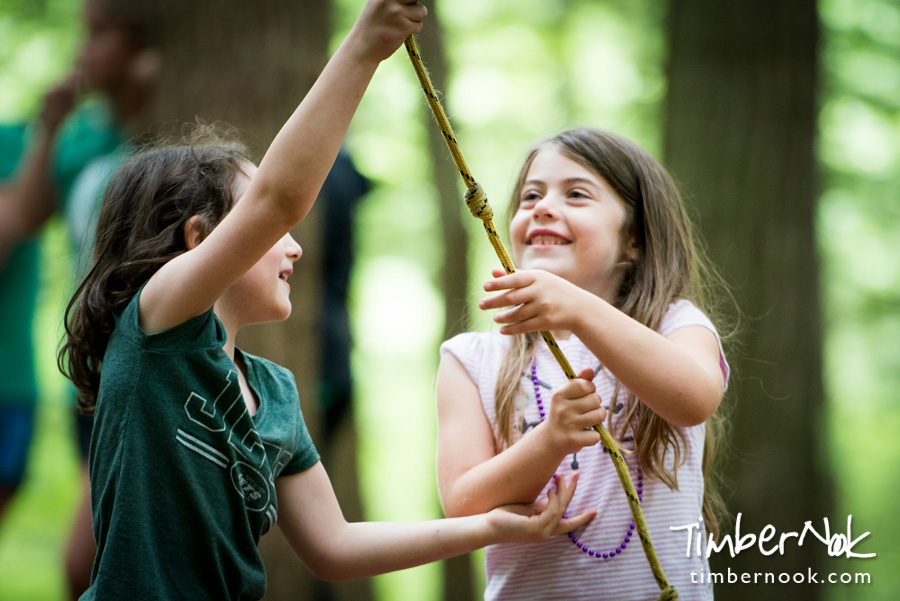By Becky Bowen, M.A. CCC-SLP
I had a fantastic summer, because I got to spend it at camp. As a speech-language pathologist, I was interested in not only what the campers were doing at TimberNook, but what they were saying as well

The benefits of free play in the great outdoors are well-documented: gross motor, fine motor, sensory and cognitive skills all improve through nature’s therapeutic design. What struck me as new and very exciting was the way in which free play challenged the campers to develop essential social skills – fundamental in everyday life.
Whether they were in the pine forests of New Hampshire or the grass fields and woods of Ohio, TimberNook campers showed considerable changes in their social use of language (pragmatic language skills). These skills help children learn how to make friends and successfully interact with others.
When campers arrived on Monday morning, there was the usual awkward hush that falls over any group of people meeting for the first time. Counselors and a few of the older kids facilitated most of the interactions that morning, asking the other campers their names, ages and what they liked to do outside. As the day and week went on, an amazing thing happened: The campers found their voices.
1. Turn-taking
There was a simple tree swing made of wood and rope hanging near the center of base camp. On the first day, the kids gravitated toward it, and without any instructions from adults – formed a single-file line in the middle of the woods. They waited patiently as each child swung for 30 seconds and then allowed the next child a turn. They were so used to the structure of school recess that even without adult enforcement, they all followed these pre-conceived adult “rules.”
As free-play went on and children spread out to explore new areas, the children left at the swing changed the rules. They continued to take turns, but one child helped the other to climb onto the swing while another pushed and spun them until they decided it was time to switch. Everyone was engaged, and no one was waiting in line.
2. Turn-taking in conversation
Another remnant of school that followed the campers into free-play was hand-raising. Initially, campers would not speak to an adult or the group without raising their hands and waiting to be called on. Very quickly, the campers realized that this was not only unnecessary, but wasted a lot of time they could be using to play.
I assumed that without this structure everyone would talk over each other and chaos would ensue. I was only partially right. Kids did talk over each other – they interrupted each other, and had to restate what they were saying to make sure they were heard. But what struck me most was how natural the dynamic was. It sounded like any adult brainstorming session where people get excited, throw out new ideas and then catch themselves when they start to dominate a conversation. These children knew the concept of turn taking, but were taking it to the next level by practicing the way it’s applied in real life.
3. Conflict Resolution
Well-meaning parents and teachers want to protect children both physically and emotionally. When a conflict arises between two children, oftentimes, loving adults nip it in the bud by intervening to avoid unpleasant emotions and to avoid judgments from other parents. This teaches our children that conflict is bad, scary, and something to be avoided at all costs. Anxiety abounds around this perfectly normal aspect of human interaction and some of these children grow into fearful adults.
Conflicts naturally arise in play. I saw this at TimberNook. Three children all wanted to be the biggest billy goat in the story, The Three Billy Goats Gruff; four kids needed scissors but there were only three available; an accidental bump sends a stick fort crashing to the ground; and everyone wanted to be the first one to roast a marshmallow over the campfire. The key is in how adults respond to these situations.
The typical response of stepping in is often making an executive decision to solve the problem and informing the children of the resolution. But this is a quick fix. It solves the momentary problem but also teaches children to fear and avoid conflict by going to an adult for a solution. I kept count of how many times counselors were approached by campers looking for an adult to solve their conflict. On Monday it was 27.
Instead of solving the conflict for them, we simply responded, “I wonder how you’ll handle that?” This put the ball back in their court and they had to start thinking.
Initially, campers were frustrated. They were used to adults stepping in quickly to solve their problems. But this approach taught them that it’s OK and normal to have disagreements; that they are capable of coming up with solutions; and most importantly, it gives them the opportunity to practice the essential life skills of conflict resolution.
By Friday, the number of requests for adult intervention was down to 1.
On the last day of camp, a little boy who had been practicing (and struggling with) social skills for much of the week had a lightbulb moment. While hiking out of the woods toward the parking lot he turned to me and said, “I like to play in the woods, but it’s way more fun with your friends.”
By providing children the space, time, and resources they need — they really do say the most amazing things.
About the Author, Rebecca Bowen, M.A. CCC-SLP
Becky is a speech-language pathologist and TimberNook provider in Greater Cleveland, Ohio who has dedicated her career to helping children find their voices, and to understand and express themselves in fun and functional ways. She knows that speech and language are so much more than sounds, words and sentences. She believes that children need meaningful hands-on experiences – and friends to share them with – to develop appropriate communication skills.
Becky spent several summers in college as a nature camp counselor and is thrilled to combine her passion for child development with her love of the outdoors. She enjoys hiking, yoga and exploring new places. She lives near Cleveland with her husband and three young children.
